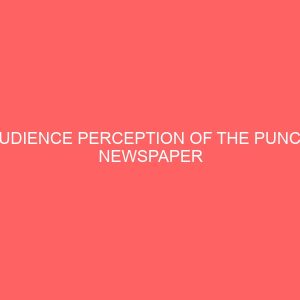Description
ABSTRACT
Cartoons have more recently become a prominent feature in newspapers. An increasing number of publishers and editors have realised its relevance and are beginning to exploit its full potentials. Despite its usefulness and popularity which is assuming a viral dimension in many media houses, one wonders, as replete and common place as these cartoons are in newspapers, do they command the attention, let alone the readership of the reading audience Hence, this researcher sought to know the pattern and trend of: Audience perception of The Punch newspaper cartoons: using Caritas University as a study. Employing the survey research method, enabled by administering self administered questionnaires, this study found out that newspaper readership and newspaper cartoon readership is generally high among Caritas respondents. Six out of every ten lecturers read cartoons on a daily basis, while two out of every ten students read cartoons every day. Cartoon readership decreased as student readers got older. Among the lecturers, readership of cartoons increased with age contrary to findings among students. With the humour and the inherent message being the major reasons why readers read cartoons, it is clear that cartoons are not seen as mere pieces of drawing to make readers laugh, rather it leaves a trail of telltale message in its wake. Even though this study revealed that cartoons are not essentially why people buy newspapers, many newspaper readers do not consider their reading experience complete without reading one or two cartoons. This, perhaps, explains why seven out of every twenty Caritas student reads The Punch newspaper and ten out of every twenty Caritas lecturer reads the same newspaper as revealed by the study. Going by the various findings of this study, more newspapers need to incorporate cartoons into their editorial menu, using it more strategically, appropriately and responsibly. Religion, ethnicity, tribalism, sectionalism and bigotry should be downplayed in cartoons and in fact avoided. The researcher equally lends his voice to the effect that cartoonists should steer clear of issues that can cause libel because libel costs millions.
CHAPTER ONE INTRODUCTION
1:1 BACKGROUND OF THE STUDY
Communication being a mandatory factor for interaction and correlation, stipulates the need to communicate with individuals in a contemporary civilization which is a basic requirement for survival, just as food, clothing, shelter e.t.c. are essential for human existence.
Communication, the most vital form of human interaction, is absolutely necessary for any enduring human relationship, be it interpersonal or international. Groups, institutions, organizations and nations exist by virtue of communication and cease to exist once communication is totally interfered with.
Communication therefore, is the livewire of any society and the world at large. It stipulates the paramount factor of unification due to the fact that a society that is kept incommunicado is a dead one. Indeed, communication is the fulcrum of social intercourse and the mirror through which society sees itself.
Cooley in Daramola 2003:1 asserts that communication is the mechanism through which human relationship exist and develops. It is through effective communication that every part of the society is accessed and social and institutional changes effected.
Communication is, undisputedly the carrier of social system. It shapes people and people shape it. Proper and effective communication provides useful information that enables people make informed decisions and well executed actions.
In compliance to dissemination of information and communicating effectively are journalists. Journalists who are professionals trained for the collection, processing, correlation and dissemination of information, are powerful gatekeepers and actors whose work sustain a society. The print media journalist through their news stories, editorials and opinions contained in newspapers and magazines, not only set the agenda for public discourse, but also reflect the environment.
Casmus in Abdulsalaam 1987:49 has said a newspaper is a nations conscience.
Akinfeleye 2003:18 observes that journalists are public servants informing members of the public on issues of public interest.
Essentially, they are the watchdogs who keep watch on the institutions of the society. They are, therefore expected to inform and educate the people and also create a forum which affords people the opportunity to examine and consider all sides there are to an issue.
Modern newspaper tends to carry many light and sensitive materials including articles written in a light mood. This feature fulfils the entertainment function of a newspaper. Among the light content is the cartoon.
1:2 STATEMENT OF THE PROBLEM
True, many newspapers are replete with burlesque representations in the form of cartoons which are used to pass across various messages, these cartoons to some people help lighten the mood from stress when going through these newspaper cartoons, giving them a sense of humour and freedom laughing through these caricatures.
Regardless of the readership of newspaper cartoons, specifically in Caritas University which triggers a sense of reasoning as to what truly motivates the readership of newspaper cartoons among lecturers and students of Caritas University; probably the readership of newspaper cartoons by lecturers and students help motivate the buying of newspapers. Also, educational advancement on the part of lecturers and students might aid a better understanding of newspaper cartoons and probably the effects of gender on newspaper cartoon readership understanding, also pertaining to the social classification of individuals this research tends to find out if demographic factors have an effects on the understanding of newspaper cartoons on lecturers and students of Caritas University.
These problems and many more are what this research work tends to find out in the course of research, using Caritas University as population.
Also, cartoons tend to be perceived by many newspaper readers from an entertainmentladen perspective, sometimes considered by intellectuals to be for the simple minded and less intelligent, but inappropriate for more serious minded people. Williams Stephenson lends credence to this claim in his Play Theory of mass communication when he posited that many people use media messages more for pleasure and relaxation than for information and improvement.
Hence, Aina 2003 states that it is not surprising that some people view only musicals and drama on television, while also concentrating on fashion and comics in newspapers and magazines. This study therefore, sought to find out what other values people sought from reading cartoons other than the entertainment value and if lecturers and students considers cartoons to be for the simple minded In all, this research work studied the psychosociological attributes affecting readership patterns of newspaper cartoons; how individual differences and social categories affected the readership patterns of newspaper cartoons.
1:3 OBJECTIVE OF THE STUDY
1.To find out whether newspaper cartoons are read, by lecturers and students of Caritas University.
2.To find out what other value outside humour that newspaper cartoons provide.
3.To assess how demographic factors affect cartoon readership.
4.To find out whether cartoon messages are understood.








Reviews
There are no reviews yet.